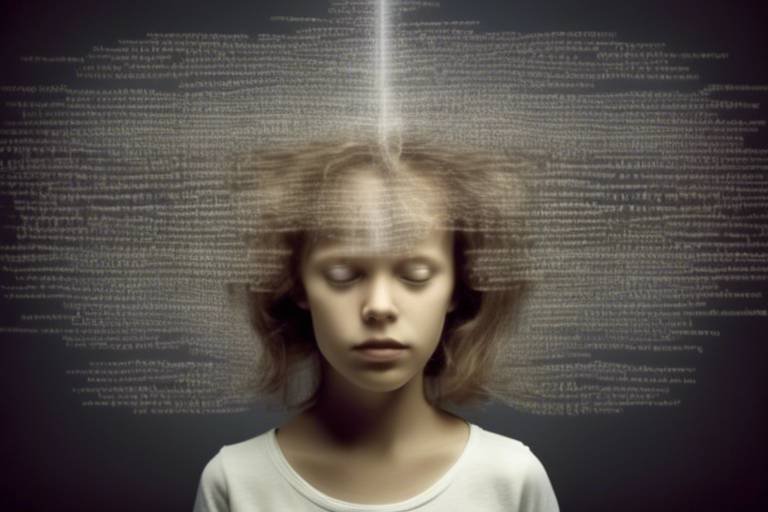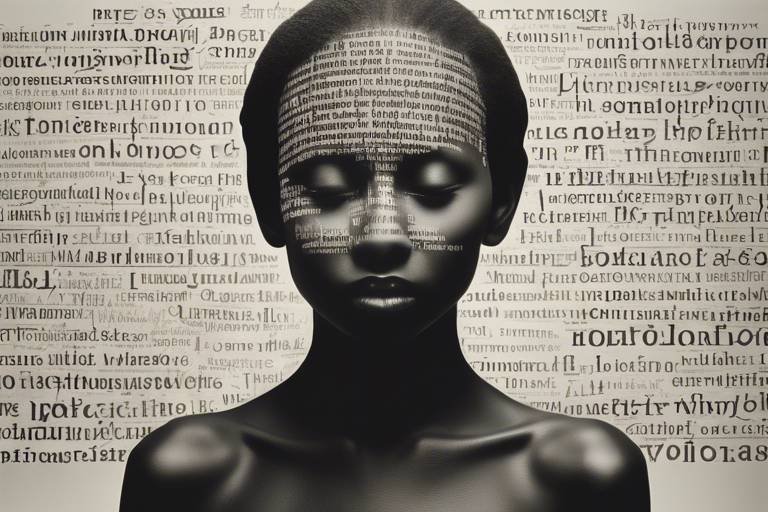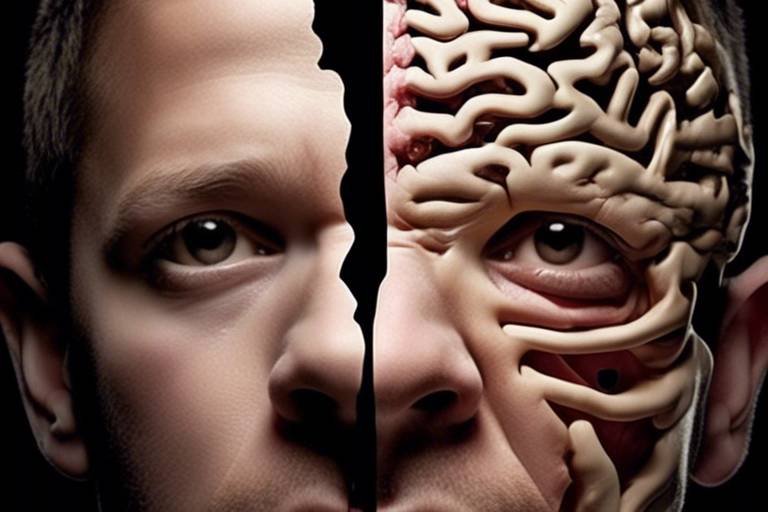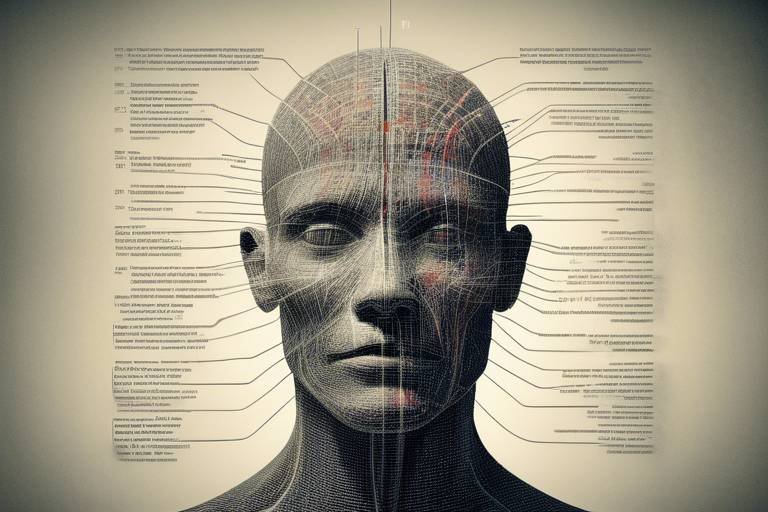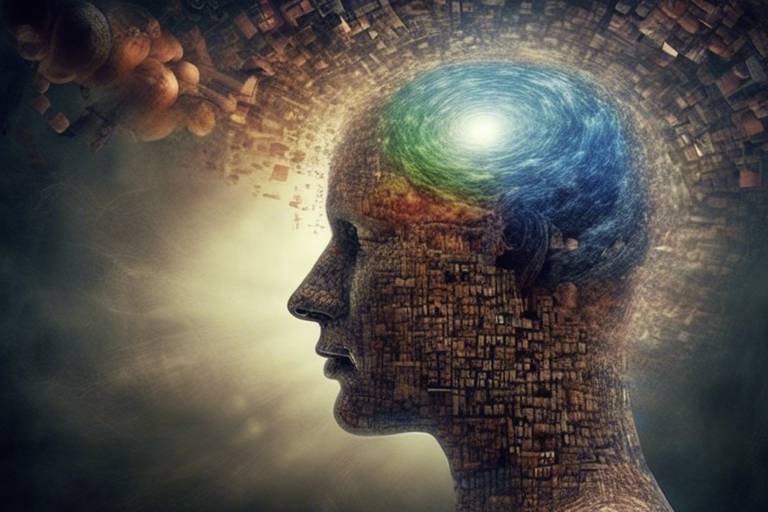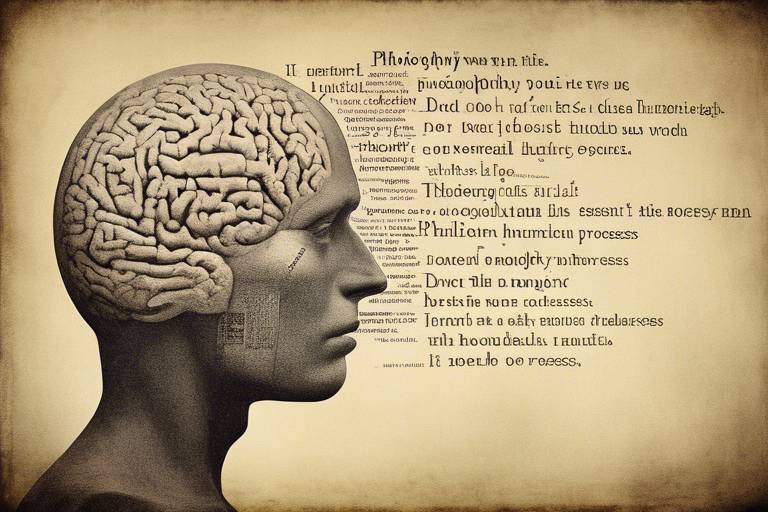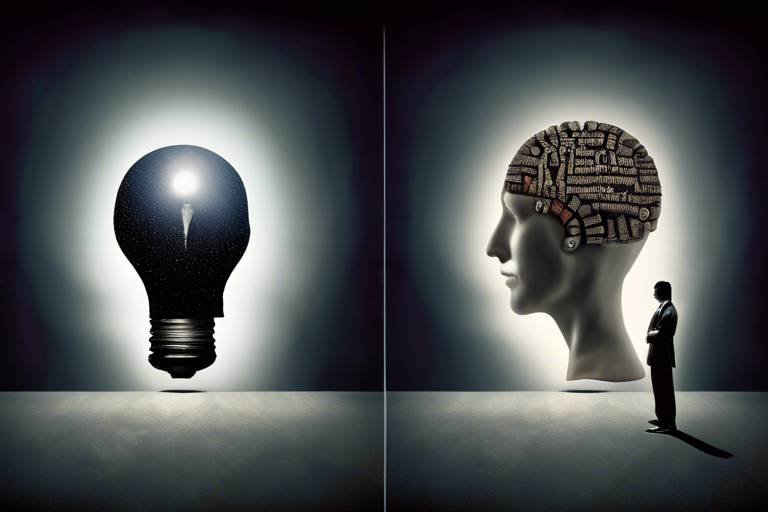The Impact of Perception on Consciousness
Have you ever stopped to think about how your perception shapes your understanding of the world around you? It's a fascinating concept that intertwines with our consciousness, influencing everything from our thoughts and feelings to our daily experiences. In this article, we will dive deep into the intricate relationship between perception and consciousness, exploring how they shape our reality and affect our interactions.
At its core, perception is the lens through which we view our surroundings. It's not just about what we see, hear, or feel; it's about how we interpret those sensory inputs. Think of perception as a filter that colors our experiences, often leading us to different conclusions based on the same set of data. The way we perceive things can drastically change our emotional responses and decision-making processes. For instance, two people can witness the same event but walk away with entirely different interpretations based on their perceptions. Isn't that mind-boggling?
As we embark on this exploration, we will uncover various aspects of how perception influences consciousness. From the role of sensory input to the impact of cultural contexts, we will see how these elements intertwine to create our unique experiences. So, buckle up as we navigate through the fascinating world of perception and consciousness!
Perception is a complex process that involves the brain interpreting sensory information from the environment. It's like being an artist, where the canvas is your mind and the colors are the sensory data you receive. Understanding the nature of perception is crucial because it serves as the foundation for our conscious experiences. When we perceive something, we don't just passively receive information; we actively construct our understanding of reality.
Consider this: when you hear a song, you don't just hear the notes. Your brain processes the melody, the lyrics, and even the memories associated with that song. This active engagement shapes your emotional response and influences your conscious experience. This is why music can make us feel nostalgic or energized. In essence, perception is not just about the senses; it's about how those senses interact with our minds to create a rich tapestry of consciousness.
Sensory input is the bedrock of our perceptions. Our senses—sight, hearing, touch, taste, and smell—provide us with the raw data needed to interpret our surroundings. Each sense contributes uniquely to our conscious experience. For example, the smell of fresh bread can evoke feelings of comfort and warmth, while the sound of thunder might trigger anxiety. These sensory inputs can alter our understanding of reality in profound ways.
Visual perception is particularly powerful in shaping our consciousness. Our eyes are like windows to the world, and what we see can significantly influence our thoughts and emotions. For instance, bright colors can energize us, while muted tones may induce calmness. This is where the fascinating interplay between color and emotion comes into play.
Colors are more than just visual stimuli; they have psychological effects that can impact our mood and behavior. For example, red is often associated with passion and excitement, while blue can evoke feelings of tranquility and sadness. Understanding these associations can help us navigate our emotional landscapes and enhance our conscious awareness.
Depth perception is another crucial aspect that allows us to navigate our environment effectively. It helps us judge distances and perceive spatial relationships. Imagine trying to catch a ball without depth perception; it would be a challenging task! This ability to perceive depth not only aids in our physical interactions but also enriches our conscious experience by providing a sense of orientation in the world.
Auditory perception also plays a significant role in shaping our conscious experience. Sounds and music can evoke powerful emotions and memories, influencing our awareness and interactions. For instance, a familiar tune can transport you back to a specific moment in time, stirring emotions you thought were long forgotten. This auditory connection deepens our conscious experience and adds layers to our perception of reality.
Our perceptions often shape our understanding of reality, leading to subjective experiences that can differ vastly from objective truths. This raises intriguing philosophical questions about the nature of reality itself. Are we truly seeing the world as it is, or are we merely experiencing a version of it filtered through our perceptions?
Cognitive biases can distort our perceptions, leading to flawed interpretations of reality. These biases are like mental shortcuts that our brains take, but they can often lead us astray. For example, confirmation bias causes us to seek out information that supports our existing beliefs while ignoring contradictory evidence. This can create a skewed perception of reality that influences our conscious thought processes.
Cultural context plays a vital role in shaping perception. Different cultures have distinct ways of interpreting experiences, which can significantly impact our consciousness. For instance, what may be considered polite behavior in one culture could be seen as rude in another. This cultural lens through which we view the world adds another layer of complexity to our understanding of perception and consciousness.
The relationship between perception and consciousness extends to the mind-body connection. Our physical sensations can influence our mental state and conscious awareness. For instance, feeling tense or relaxed can affect how we perceive our surroundings and interact with others.
Practicing mindfulness can enhance our awareness of perceptions. By being present in the moment, we can cultivate a deeper understanding of our sensory experiences. Techniques such as meditation and focused breathing can help us tune into our perceptions and improve our conscious awareness.
Bodily awareness is crucial for understanding our emotions and perceptions. By tuning into our physical sensations, we can deepen our conscious experience and foster a greater connection between our mind and body. This awareness can lead to more informed decisions and a richer understanding of our emotional landscape.
- What is the difference between perception and consciousness?
Perception is the process of interpreting sensory information, while consciousness refers to our awareness of those perceptions and our thoughts and feelings about them. - How do cognitive biases affect our perceptions?
Cognitive biases can lead us to interpret information in a way that confirms our existing beliefs, distorting our perception of reality. - Can mindfulness improve my perception?
Yes! Practicing mindfulness can enhance your awareness of sensory experiences, helping you to perceive the world more clearly.

The Nature of Perception
Perception is a fascinating and intricate process through which we interpret sensory information, and it plays a pivotal role in shaping our understanding of the world. Think of it as a lens through which we view reality; this lens can be tinted by our experiences, emotions, and even cultural backgrounds. When we talk about perception, we're diving into a realm that influences not just how we see things, but also how we feel and react to them. It's like a complex puzzle where each piece contributes to the bigger picture of our consciousness.
At its core, perception involves several stages, starting with the reception of stimuli through our senses. These stimuli are then processed and interpreted by our brain, leading to a conscious experience. It's important to note that perception is not merely a passive reception of information; rather, it is an active process that involves our previous knowledge, expectations, and context. For instance, when you hear a familiar song, it might evoke memories from your past, changing your emotional state and influencing your current feelings. This interplay between sensory input and cognitive processing is what makes perception so dynamic and essential to our daily lives.
Moreover, perception is inherently subjective. What one person perceives can differ vastly from another's experience. This subjectivity is influenced by various factors, including:
- Personal Experiences: Our past experiences shape how we interpret new information. A person who has had a negative encounter with a dog may perceive all dogs as threatening, while a dog lover sees them as friendly companions.
- Emotional State: Our current emotional state can color our perceptions. Feeling happy might make us more optimistic about a situation, while sadness could lead us to interpret events more negatively.
- Cultural Background: Different cultures can have unique interpretations of the same stimuli. For example, colors may have different meanings in various cultures, affecting how they are perceived and understood.
Understanding the nature of perception is crucial for grasping its profound impact on our conscious experiences. It is this intricate dance between sensory input and cognitive interpretation that shapes our reality, influencing everything from our decisions to our interactions with others. In essence, perception is the gateway to our consciousness, guiding us through the complexities of life. By exploring how we perceive the world, we can better understand ourselves and the myriad ways our consciousness is shaped.
- What is the difference between perception and sensation?
Sensation refers to the initial detection of stimuli through our senses, while perception is the interpretation and understanding of those stimuli. In other words, sensation is about raw data, and perception is about meaning.
- How does perception influence our behavior?
Our perceptions shape our beliefs and attitudes, which in turn influence our actions. For example, if we perceive a situation as threatening, we may respond with fear or avoidance.
- Can perception be changed?
Yes, perception can be altered through new experiences, education, and mindfulness practices. By becoming aware of our biases and expanding our perspectives, we can reshape how we perceive the world.

The Role of Sensory Input
Sensory input is the bedrock of our perception, acting as the gateway through which we experience the world around us. Imagine stepping into a bustling market; the vibrant colors of fresh produce, the aromatic scents wafting from food stalls, and the cacophony of voices create a rich tapestry of sensory experiences. Each sense—sight, sound, touch, taste, and smell—contributes uniquely to our understanding of reality, shaping our thoughts and feelings in profound ways. Our brain processes these sensory signals, weaving them together to form a coherent picture of our environment. But how exactly does this sensory input influence our consciousness?
Each sense plays a pivotal role in crafting our conscious experience. For instance, visual input not only informs us about our surroundings but also stirs emotions and memories. A simple glance at a photograph can transport us back in time, evoking nostalgia or joy. Similarly, auditory input, like the sound of waves crashing on the shore, can instill a sense of calm or trigger vivid recollections of past vacations. The interplay between these senses is intricate and fascinating, often leading us to perceive things that may not align with objective reality.
To illustrate the impact of sensory input on our consciousness, consider the following table that summarizes how each sense contributes to our overall perception:
| Sensory Input | Impact on Consciousness |
|---|---|
| Visual | Shapes emotions, influences decisions, and creates mental imagery. |
| Auditory | Evokes memories, sets mood, and enhances communication. |
| Olfactory | Triggers strong emotional responses and recalls vivid memories. |
| Tactile | Provides physical comfort or discomfort, influencing emotional states. |
| Gustatory | Shapes preferences, influences social interactions, and evokes nostalgia. |
As we navigate our daily lives, the constant influx of sensory information helps us make sense of our experiences. For example, when we hear a familiar song, it may evoke feelings of happiness or sadness based on the memories associated with it. This illustrates the profound connection between our sensory experiences and our emotional states. Moreover, our senses can sometimes deceive us, leading to misinterpretations of reality. Have you ever experienced a situation where your eyes played tricks on you, making you see something that wasn’t there? Such phenomena remind us that while our senses provide valuable information, they are not infallible.
In conclusion, sensory input is a crucial component of our consciousness, shaping our perceptions and experiences in ways we often take for granted. By understanding how each sense contributes to our conscious awareness, we can better appreciate the richness of our experiences and the complexity of our interactions with the world. So, the next time you find yourself in a vibrant environment, take a moment to reflect on how your senses are working together to create your unique conscious experience.

Visual perception is one of the most profound ways we interact with the world around us. Imagine walking through a vibrant forest, where the sunlight filters through the leaves, casting intricate patterns on the ground. This experience is not just about seeing; it’s about how we interpret and understand what we see. Our brains take in a myriad of visual stimuli, from colors and shapes to movement and depth, and transform them into meaningful experiences. This complex process is crucial for shaping our consciousness, influencing our thoughts, emotions, and even our decision-making.
But how does this all work? When we look at something, our eyes capture light and send signals to our brain. The brain then interprets these signals based on our past experiences, expectations, and context. This means that two people can look at the same scene and come away with entirely different interpretations. For instance, consider a painting that evokes joy for one person and confusion for another. This subjectivity highlights the power of visual perception in shaping our conscious experience.
Moreover, visual perception is not just about passive observation; it actively influences our emotions and behaviors. Research has shown that certain visual stimuli can trigger emotional responses. For example, bright colors like yellow and orange often evoke feelings of happiness and energy, while darker shades like blue and gray can elicit sadness or calmness. This interplay between color and emotion is a fascinating area of study, revealing how deeply intertwined our perception of color is with our emotional state.
Colors have a profound psychological impact on our mood and behavior. For instance, the color red is often associated with passion and urgency, which is why it’s frequently used in marketing to grab attention. On the other hand, blue is typically seen as calming and is often used in spaces designed for relaxation. Understanding these associations can help us navigate our environments more effectively and even influence our choices. Here’s a quick overview of how different colors can affect us:
| Color | Emotional Impact |
|---|---|
| Red | Passion, urgency, excitement |
| Blue | Calmness, trust, serenity |
| Yellow | Happiness, energy, optimism |
| Green | Growth, harmony, freshness |
| Purple | Luxury, creativity, mystery |
This table illustrates just a few examples of how color can influence our emotional state. By being aware of these associations, we can intentionally use colors to enhance our environments and influence our moods.
Another critical aspect of visual perception is depth perception, which allows us to gauge the distance of objects and navigate our surroundings effectively. Have you ever noticed how you instinctively reach out to grab a cup from a table? That’s depth perception at work! Our brains use various cues, such as binocular disparity (the slight difference in images between our two eyes) and motion parallax (the way objects closer to us move faster than those further away), to create a three-dimensional understanding of our environment.
This ability to perceive depth not only aids in physical navigation but also enriches our conscious experience. It allows us to appreciate the beauty of a sunset, the intricacies of a painting, or the complexity of a bustling cityscape. Without depth perception, our visual world would be flat and devoid of the richness that makes life so vibrant. In essence, visual perception is not merely about seeing; it’s about experiencing the world in all its dimensions, colors, and emotions.
In summary, visual perception is a dynamic process that shapes our consciousness in profound ways. From the colors that evoke emotions to the depth that enriches our experiences, our ability to perceive visually is intricately linked to how we understand and interact with the world. As we continue to explore the nuances of perception, we uncover the layers of consciousness that define our human experience.
- What is visual perception? Visual perception is the process by which our brains interpret visual stimuli from our environment, allowing us to understand and interact with the world around us.
- How does color affect our emotions? Different colors can evoke specific emotional responses, influencing our mood and behavior. For example, warm colors like red can create excitement, while cool colors like blue can induce calmness.
- What is depth perception? Depth perception is the ability to perceive the distance of objects in our environment, enabling us to navigate and interact with our surroundings effectively.
- Can visual perception vary between individuals? Yes, visual perception can differ from person to person based on factors such as past experiences, cultural background, and even individual psychological states.

Colors are not just visual stimuli; they are powerful emotional triggers that can deeply influence our mood, behavior, and overall conscious experience. Imagine walking into a room painted in a bright yellow hue; it’s likely to evoke feelings of happiness and energy. In contrast, a dimly lit space adorned with deep blue tones might instill a sense of calm or even sadness. This phenomenon is not merely coincidental; it is rooted in the psychological effects that colors have on our minds.
Research has shown that different colors can elicit distinct emotional responses. For instance, red is often associated with passion and urgency, making it an excellent choice for marketing strategies aimed at grabbing attention. On the other hand, green is linked to tranquility and nature, often used in spaces designed for relaxation. Here’s a quick overview of some common colors and their associated emotions:
| Color | Associated Emotion |
|---|---|
| Red | Passion, Energy |
| Blue | Calm, Trust |
| Yellow | Happiness, Optimism |
| Green | Peace, Growth |
| Purple | Creativity, Luxury |
These associations can vary based on personal experiences and cultural contexts, but the overarching principle remains: color profoundly shapes our emotional landscape. For example, think about how a bright orange sunset can evoke feelings of nostalgia and warmth, while a gray, overcast day might lead to feelings of melancholy. This interplay between color and emotion highlights the subjective nature of perception.
Furthermore, the impact of color extends beyond our immediate emotional responses. It can also influence our decision-making processes and interactions with others. For instance, people are more likely to make impulsive decisions in environments dominated by red, while blue settings tend to promote more thoughtful and deliberate choices. This is why understanding the psychological effects of color is crucial in fields like marketing, design, and even therapy.
In essence, color acts as a silent yet powerful communicator, shaping our conscious experience in ways we often overlook. By becoming more aware of how colors affect our emotions, we can harness their power to create environments that enhance our well-being and influence our interactions positively.
- How do colors affect our emotions? Colors can evoke specific feelings and moods, influencing our emotional state and behavior.
- Can the effects of color vary between cultures? Yes, cultural interpretations of colors can differ significantly, leading to varied emotional associations.
- Is there scientific evidence supporting the impact of color on mood? Yes, numerous studies have demonstrated the psychological effects of color on emotions and decision-making.
- How can I use color to improve my environment? Consider the emotional impact of colors when decorating your space to create a desired mood or atmosphere.

Depth perception is an incredible ability that allows us to perceive the world in three dimensions, giving us a sense of space and distance. Imagine trying to catch a ball without being able to judge how far away it is; it would be a game of chance rather than skill. Our ability to understand depth is crucial in navigating our environment, interacting with objects, and engaging in activities that require precision, such as driving or playing sports. But how does this fascinating process work?
At its core, depth perception relies on a combination of visual cues that our brain interprets to create a coherent picture of our surroundings. These cues can be categorized into two main types: binocular cues and monocular cues. Binocular cues involve the use of both eyes, where our brain processes the slightly different images received from each eye to gauge distance. This phenomenon is known as stereopsis. On the other hand, monocular cues rely on information from a single eye, such as size, texture, and motion parallax, which help us perceive depth even when one eye is closed.
To illustrate, let’s consider some common monocular cues:
- Relative Size: Objects that are closer appear larger than those that are further away.
- Linear Perspective: Parallel lines seem to converge as they recede into the distance.
- Interposition: When one object overlaps another, we perceive the overlapping object as being closer.
These cues work together seamlessly, allowing us to navigate our world with ease. However, depth perception isn't just about seeing; it also influences our conscious experience. For instance, when we watch a movie in 3D, our brain uses depth cues to create a more immersive experience, making us feel as though we are part of the action. This interplay between depth perception and consciousness can evoke strong emotions, making us feel excitement, fear, or even nostalgia, depending on the scene.
Moreover, depth perception is not solely a visual phenomenon; it is intertwined with our motor skills and body awareness. When we reach for an object, our brain calculates the distance and adjusts our movements accordingly. This connection emphasizes the importance of depth perception in our daily lives, influencing everything from how we interact with others to how we engage with our environment.
In conclusion, depth perception is a vital aspect of how we experience the world. It shapes our understanding of space and distance, influences our actions, and enhances our emotional responses. By appreciating the complexity of depth perception, we can gain a deeper insight into how our consciousness is intricately tied to the way we perceive reality.

Auditory perception is a fascinating aspect of our consciousness that shapes how we experience the world around us. It's not just about hearing sounds; it's about how those sounds influence our emotions, thoughts, and interactions. Imagine walking through a bustling city street where the cacophony of honking cars, chattering pedestrians, and distant music creates a vibrant tapestry of sound. Each sound wave carries with it an emotional weight, a memory, or even a sense of urgency that can alter our state of mind. Sound has the power to evoke feelings and trigger memories, making it a crucial element in shaping our conscious experience.
One of the most intriguing elements of auditory perception is how music can profoundly affect our emotional state. Think about the last time you listened to a song that made you feel nostalgic or exhilarated. Music has a unique ability to resonate with us on a personal level, often transporting us back to specific moments in our lives. This phenomenon occurs because our brains process music in a way that links it to our emotions and memories. For example, a joyful tune can elevate our mood, while a melancholic melody might evoke feelings of sadness or reflection.
Moreover, auditory perception also plays a significant role in communication. The nuances of tone, pitch, and volume can convey meaning beyond the words themselves. Consider how a simple "hello" can sound warm and inviting or cold and distant, depending on the speaker's tone. This aspect of auditory perception is crucial in social interactions, as it helps us interpret the feelings and intentions of others. It's fascinating to realize that our understanding of a conversation is shaped not just by the words spoken, but by the auditory cues that accompany them.
Furthermore, our ability to perceive sound is not limited to music and conversation; it extends to the environment around us. The sounds of nature, like chirping birds or rustling leaves, can have a calming effect, while loud, jarring noises can induce stress or anxiety. This relationship between sound and our emotional state highlights the importance of auditory perception in our overall well-being. Engaging with soothing sounds, such as a gentle stream or soft rain, can enhance relaxation and mindfulness, allowing us to connect more deeply with our surroundings.
Interestingly, auditory perception also intersects with cognitive processes. For instance, studies have shown that background music can influence our productivity and focus. Some people find that listening to instrumental music helps them concentrate, while others may prefer silence. This variability underscores the subjective nature of auditory perception—what works for one person might not work for another. It's a reminder that our conscious experience is uniquely tailored by our perceptions, including how we respond to sound.
In conclusion, auditory perception is a vital component of our consciousness that shapes our experiences, emotions, and interactions. It influences how we connect with others, how we feel in different environments, and even how we engage with our own thoughts. By understanding the profound impact of sound on our consciousness, we can appreciate the richness of our auditory experiences and their role in shaping who we are.
- What is auditory perception?
Auditory perception refers to the process by which we interpret and make sense of sounds in our environment, influencing our emotions and experiences. - How does music affect our emotions?
Music can evoke a wide range of emotions by triggering memories and feelings, impacting our mood and overall state of mind. - Why is tone important in communication?
Tone conveys meaning beyond words, helping us interpret the feelings and intentions of the speaker, which is crucial for effective communication. - Can sound influence productivity?
Yes, background sounds, including music, can either enhance or hinder focus and productivity, depending on individual preferences.

Have you ever wondered why two people can witness the same event and come away with completely different stories? This fascinating phenomenon highlights the intricate relationship between perception and reality. Our perceptions are not just passive reflections of the world around us; they actively shape our understanding of reality. In this section, we will delve into the philosophical implications of perception, exploring how our subjective experiences can create realities that diverge from objective truths.
At the heart of this discussion lies the idea that perception is inherently subjective. Each of us interprets sensory information through the lens of our unique experiences, beliefs, and emotions. For instance, consider how a person might perceive a piece of art. One viewer may see beauty and inspiration, while another may feel confusion or even disdain. This divergence stems from individual backgrounds, cultural influences, and personal experiences that color our interpretations. As a result, our realities are often constructed from a patchwork of perceptions, leading to a rich tapestry of human experience.
Moreover, cognitive biases play a significant role in how we perceive reality. These biases are mental shortcuts that our brains use to process information quickly, but they often lead to distorted interpretations. Here are a few common cognitive biases that can skew our perceptions:
- Confirmation Bias: This is the tendency to seek out information that confirms our existing beliefs while ignoring contradictory evidence.
- Anchoring Bias: This occurs when we rely too heavily on the first piece of information we encounter, which can skew our judgment and decision-making.
- Hindsight Bias: Often referred to as the "I-knew-it-all-along" effect, this bias leads us to believe that past events were more predictable than they actually were.
These biases can create a distorted lens through which we view the world, leading to misconceptions and misunderstandings. They illustrate how our perception can deviate from an objective reality, highlighting the complexity of human consciousness.
Furthermore, cultural context plays a crucial role in shaping our perceptions and, consequently, our realities. Different cultures have distinct ways of interpreting experiences, which can lead to vastly different understandings of the same event. For example, consider the varying interpretations of time across cultures. In some cultures, punctuality is seen as a sign of respect, while in others, a more relaxed approach to time is the norm. This divergence in cultural perception can lead to misunderstandings in social interactions and relationships.
In essence, our perceptions are not merely reflections of reality; they are active constructions influenced by a myriad of factors, including our cognitive biases and cultural backgrounds. This understanding invites us to approach our interactions with others with a sense of curiosity and openness. By recognizing that each person's perception is shaped by their unique experiences, we can foster empathy and improve communication.
So, the next time you find yourself in a disagreement or confusion, take a moment to consider: What is shaping my perception? What biases might be at play? And how might the other person's background influence their understanding? By asking these questions, we can begin to untangle the complex web of perception and reality, leading to richer, more meaningful interactions with those around us.
- What is the difference between perception and reality? Perception refers to how we interpret sensory information, while reality is the objective state of things as they exist independent of our perceptions.
- How do cognitive biases affect our perceptions? Cognitive biases can distort our interpretations of information, leading us to form flawed conclusions and beliefs about reality.
- Can cultural differences influence perception? Absolutely! Cultural context shapes how we interpret experiences, leading to diverse understandings of the same events.

Cognitive biases are fascinating quirks of human thought that can significantly distort our perceptions and influence our conscious experiences. Imagine walking into a room and instantly feeling uneasy, only to later realize that your discomfort stemmed from a shadow cast by a piece of furniture. This simple example illustrates how our brains can misinterpret sensory information, leading us to draw incorrect conclusions about our surroundings. In essence, cognitive biases act like a pair of tinted glasses that color our view of reality, often in ways we are unaware of.
These biases arise from our brain's attempt to simplify information processing, allowing us to make quick decisions without overthinking every detail. However, this shortcut approach can lead to flawed interpretations of reality. For instance, the confirmation bias causes us to seek out information that confirms our existing beliefs while ignoring evidence that contradicts them. This can create a skewed perception of the world, reinforcing our preconceived notions and limiting our understanding.
Another common bias is the availability heuristic, which occurs when we rely on immediate examples that come to mind when evaluating a situation. For example, if we frequently hear about airplane accidents on the news, we may overestimate the dangers of flying, despite it being one of the safest modes of transportation. This bias can lead to heightened anxiety and irrational fears, shaping our conscious experiences in ways that don't align with reality.
To illustrate the impact of cognitive biases on our perception, consider the following table that highlights some common biases and their effects:
| Bias | Description | Impact on Perception |
|---|---|---|
| Confirmation Bias | Favoring information that confirms existing beliefs | Reinforces misconceptions and limits understanding |
| Availability Heuristic | Relying on immediate examples that come to mind | Leads to exaggerated perceptions of risk |
| Anchoring Bias | Relying too heavily on the first piece of information encountered | Distorts decision-making and evaluations |
| Hindsight Bias | The tendency to see events as having been predictable after they have occurred | Can lead to overconfidence in one's ability to predict outcomes |
Understanding these biases is crucial for enhancing our conscious awareness. By recognizing how these mental shortcuts can distort our perceptions, we can make more informed decisions and develop a clearer understanding of the world around us. It's like having a map that highlights potential pitfalls, allowing us to navigate our thoughts and emotions more effectively.
In conclusion, cognitive biases are powerful influences on our perception and consciousness. They shape how we interpret experiences, form judgments, and interact with the world. By becoming aware of these biases, we can strive for a more accurate understanding of reality, ultimately enriching our conscious experience.
- What are cognitive biases? Cognitive biases are systematic patterns of deviation from norm or rationality in judgment, leading to illogical conclusions.
- How do cognitive biases affect decision-making? They can lead to flawed interpretations and decisions, often based on incomplete or distorted information.
- Can we overcome cognitive biases? While it's challenging, awareness and critical thinking can help mitigate their effects on our perceptions.
- Why is it important to understand cognitive biases? Understanding them helps improve our decision-making and enhances our awareness of how we perceive reality.

Culture is like a lens through which we perceive the world around us. It shapes our beliefs, values, and ultimately, our consciousness. Think of culture as a set of glasses that colors everything we see and experience. From the moment we are born, we are immersed in cultural narratives that guide our understanding of reality. For instance, consider how different cultures interpret emotions. In some cultures, expressing emotions openly is encouraged, while in others, it may be seen as a sign of weakness. This cultural backdrop can significantly influence how we perceive our own feelings and those of others, creating a unique tapestry of consciousness.
Furthermore, culture impacts our social interactions and the way we communicate. Language, a crucial element of culture, shapes our thoughts and perceptions. The Sapir-Whorf hypothesis suggests that the language we speak can influence the way we think. For example, some languages have words for concepts that others do not, which can lead to entirely different ways of experiencing the world. Imagine trying to express a feeling that has no direct translation in your language; it can lead to frustration and a sense of disconnect. This illustrates how cultural nuances can alter our conscious experience.
Moreover, cultural rituals and traditions play a pivotal role in shaping our perceptions. They provide a framework for understanding life events, from birth to death. For instance, in many cultures, coming-of-age ceremonies mark a transition in consciousness, signaling a shift in identity and perception of self. These rituals not only reinforce cultural values but also enhance our awareness of the world around us. They help us connect with our community and understand our place within it, emphasizing the collective aspect of consciousness.
To further illustrate the influence of culture on perception, consider the following table that summarizes various cultural perspectives:
| Cultural Aspect | Western Culture | Eastern Culture |
|---|---|---|
| Emotion Expression | Encouraged to express emotions | Often subdued, value harmony |
| Individualism vs. Collectivism | Focus on individual achievement | Emphasis on community and group |
| Language Influence | Direct and explicit communication | Indirect and context-dependent communication |
As we navigate through life, we are constantly influenced by our cultural environment. This influence can manifest in our perceptions of beauty, success, and even morality. For example, what one culture deems as beautiful may not hold the same value in another. This divergence in perception can lead to misunderstandings and conflicts, highlighting the importance of cultural sensitivity in our increasingly globalized world. In essence, culture shapes not only our perception but also our consciousness, creating a rich and diverse human experience.
- How does culture affect our emotions? Culture can dictate how we express and interpret emotions, influencing our overall emotional awareness.
- Can language shape our thoughts? Yes, the language we use can affect our thought processes and how we perceive the world around us.
- What role do rituals play in perception? Cultural rituals help frame our understanding of life events, enhancing our consciousness and sense of identity.

The relationship between perception and consciousness is a fascinating web that intertwines our mind and body, creating a rich tapestry of experiences. When we think about how we perceive the world, it's essential to acknowledge that our physical sensations play a significant role in shaping our mental state. Imagine walking through a beautiful park on a sunny day; the warmth of the sun on your skin, the sound of leaves rustling in the breeze, and the vibrant colors of flowers all contribute to a heightened sense of awareness. This connection between our physical sensations and mental perceptions is what makes our conscious experience so profound.
To illustrate this connection, consider how our body reacts to different situations. When we feel anxious, our heart races, our palms may sweat, and we might even feel a knot in our stomach. These physical sensations are not just random; they are our body’s way of communicating with our mind. This interplay can be seen in various scenarios, such as:
- Stress Responses: When faced with stress, our body enters a fight-or-flight mode, preparing us to react. This physiological change can cloud our judgment and alter our conscious perception of the situation.
- Relaxation Techniques: Practices such as yoga and meditation emphasize bodily awareness, helping to calm the mind and enhance conscious clarity.
- Physical Activity: Engaging in exercise releases endorphins, which can elevate mood and improve our overall perception of reality.
Moreover, the concept of mindfulness plays a pivotal role in enhancing our awareness of perceptions. Mindfulness is about being present in the moment and fully engaging with our thoughts and feelings without judgment. It encourages us to tune into our bodily sensations, which can lead to a deeper understanding of our emotional states and perceptions. For instance, when we practice mindfulness, we may notice how our breathing changes in response to different thoughts or emotions. This awareness fosters a greater connection between our mind and body, leading to a more enriched conscious experience.
Additionally, bodily awareness can significantly impact our emotional landscape. By paying attention to how our body feels during different emotional states, we can gain insights into our perceptions. For example, if we notice tension in our shoulders when we're stressed, we can consciously work to release that tension, thereby altering our emotional state and, consequently, our conscious awareness. This is where the mind-body connection becomes a powerful tool for enhancing our overall well-being.
In conclusion, the interconnection of mind and body is a dynamic relationship that profoundly influences our perception and consciousness. By cultivating an awareness of our physical sensations and practicing mindfulness, we can create a more harmonious balance between our mind and body. This balance not only enriches our conscious experience but also empowers us to navigate the complexities of life with greater clarity and understanding.
- What is the mind-body connection? The mind-body connection refers to the relationship between our mental states and physical sensations, highlighting how they influence one another.
- How does mindfulness enhance awareness? Mindfulness practices encourage us to focus on the present moment, helping us become more aware of our thoughts, feelings, and bodily sensations.
- Can physical activity improve mental health? Yes, engaging in physical activity can release endorphins, which improve mood and overall mental well-being.

Mindfulness is like a gentle spotlight that focuses on the present moment, illuminating our thoughts, feelings, and sensations without judgment. It's about being fully engaged with the here and now, rather than getting lost in the past or worrying about the future. Imagine standing on a busy street, where the hustle and bustle of life can easily distract you. Now, picture yourself taking a step back, observing the chaos calmly, and recognizing each sound and sight without the need to react. This is the essence of mindfulness.
When we practice mindfulness, we cultivate a heightened sense of awareness that allows us to perceive our experiences more clearly. This enhanced awareness can significantly influence our consciousness, helping us to understand our emotions and thoughts better. By being mindful, we can notice patterns in our thinking and behavior that we might otherwise overlook. For instance, you might realize that certain situations trigger feelings of anxiety or joy, and this awareness can empower you to respond rather than react. It’s like having a map that guides you through the complex terrain of your mind.
There are various techniques to develop mindfulness, each offering unique benefits. Here are a few popular methods:
- Breath Awareness: Focusing on your breath helps anchor you in the present. Notice the rhythm of your inhalation and exhalation, and let go of distracting thoughts.
- Body Scan: This involves mentally scanning your body from head to toe, paying attention to any sensations or tensions. It’s a great way to connect with your physical self.
- Mindful Observation: Choose an object, like a flower or a piece of fruit, and observe it closely. Notice its colors, shapes, and textures, allowing yourself to be fully immersed in the experience.
Practicing these techniques regularly can lead to a profound transformation in how we experience life. Studies show that mindfulness can reduce stress, enhance emotional regulation, and even improve cognitive function. As we become more aware of our perceptions, we can navigate our consciousness with greater ease, making choices that align with our true selves.
Incorporating mindfulness into your daily routine doesn’t have to be complicated. Start small—perhaps by dedicating just a few minutes each day to practice. Over time, you’ll likely find that your overall awareness expands, allowing you to engage with your surroundings and your inner self more fully. It’s like tuning a musical instrument; the more you practice, the more harmonious your life becomes.
Ultimately, mindfulness is a powerful tool for enhancing awareness and enriching our conscious experience. By learning to observe our thoughts and feelings with curiosity rather than judgment, we can create a deeper connection with ourselves and the world around us. So, why not give it a try? The journey into mindfulness may just open up new dimensions of consciousness that you never knew existed.
What is mindfulness?
Mindfulness is the practice of being fully present and engaged in the moment, observing thoughts and feelings without judgment.
How can mindfulness improve my mental health?
Mindfulness can reduce stress, anxiety, and depression by helping individuals become more aware of their thoughts and emotions, allowing for better emotional regulation.
Do I need to meditate to practice mindfulness?
While meditation is a common mindfulness practice, you can cultivate mindfulness in everyday activities, such as eating, walking, or even washing dishes.
How long should I practice mindfulness each day?
Even a few minutes of mindfulness practice can be beneficial. Start with 5-10 minutes and gradually increase the duration as you become more comfortable.

Bodily awareness is a fascinating concept that plays a crucial role in how we experience our emotions and perceptions. It's like having a built-in compass that guides us through the landscape of our feelings, helping us navigate the often turbulent waters of our consciousness. When we tune into our bodies, we can uncover a wealth of information that informs our thoughts and actions. Think about it: how often do you find yourself feeling anxious and then notice a tightness in your chest or a knot in your stomach? This connection between our physical sensations and mental states is a powerful reminder that our bodies are not just vessels; they are active participants in our conscious experiences.
Many people, however, go through life disconnected from their bodily sensations, often leading to a diminished understanding of their emotional states. This disconnection can create a gap in our consciousness, making it harder to respond to our feelings in a healthy way. By practicing bodily awareness, we can bridge this gap and enhance our overall consciousness. Techniques such as body scanning, yoga, or simply taking a moment to breathe deeply and check in with ourselves can help cultivate this awareness.
Incorporating bodily awareness into our daily routines can significantly enrich our conscious experience. Here are some techniques to enhance your bodily awareness:
- Mindful Breathing: Take a few minutes each day to focus solely on your breath. Notice how your body feels as you inhale and exhale.
- Body Scanning: Lie down comfortably and mentally scan your body from head to toe, paying attention to any sensations or areas of tension.
- Movement Practices: Engage in activities like yoga, tai chi, or dance that encourage you to connect with your body and its movements.
Research has shown that enhancing bodily awareness can lead to improved emotional regulation and greater overall well-being. When we become more attuned to our physical sensations, we are better equipped to understand and manage our emotions. This heightened awareness can lead to a more profound sense of presence in our daily lives, allowing us to experience moments more fully and authentically.
In conclusion, cultivating bodily awareness is not just about being in tune with our physical sensations; it's about embracing a holistic approach to consciousness. By recognizing the intimate connection between our bodies and minds, we can unlock new dimensions of understanding that enrich our experiences and deepen our emotional intelligence. So why not take a moment today to check in with your body? You might be surprised by what you discover.
- What is bodily awareness? Bodily awareness refers to the conscious recognition of physical sensations and how they relate to our emotional states.
- How can I improve my bodily awareness? Techniques such as mindful breathing, body scanning, and movement practices like yoga can help enhance your bodily awareness.
- Why is bodily awareness important? It helps us understand our emotions better, leading to improved emotional regulation and overall well-being.
Frequently Asked Questions
- What is the relationship between perception and consciousness?
Perception and consciousness are deeply intertwined. Our perception shapes how we experience the world, influencing our thoughts and emotions. In essence, what we perceive becomes a part of our conscious experience, affecting our understanding and interaction with reality.
- How does sensory input affect our conscious experience?
Sensory input is the foundation of perception. Each of our senses—sight, sound, touch, taste, and smell—provides unique information that contributes to our conscious experience. For instance, the way we perceive colors can evoke different emotions, while sounds can trigger vivid memories, both shaping our awareness of the moment.
- Can cognitive biases alter our perception of reality?
Absolutely! Cognitive biases can distort our perceptions, leading us to interpret situations in ways that may not align with objective reality. These biases, such as confirmation bias or the anchoring effect, can significantly influence our decision-making processes and how we understand our experiences.
- What role does culture play in shaping perception?
Culture is a powerful force in shaping how we perceive the world. Our cultural background influences our values, beliefs, and interpretations of experiences, creating subjective realities. This means that two people from different cultures can perceive the same event in entirely different ways.
- How can mindfulness enhance our perception?
Mindfulness practices encourage us to be present and fully aware of our sensory experiences. By tuning into our perceptions without judgment, we can enhance our conscious awareness and better understand our thoughts and feelings. This heightened awareness can lead to a richer, more fulfilling experience of life.
- What is bodily awareness and why is it important?
Bodily awareness refers to our ability to recognize and understand our physical sensations. It's crucial because our body often communicates our emotional states and perceptions. By being in tune with our bodily sensations, we can gain deeper insights into our consciousness and emotional well-being.

